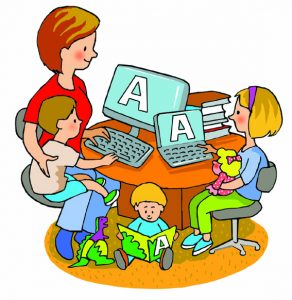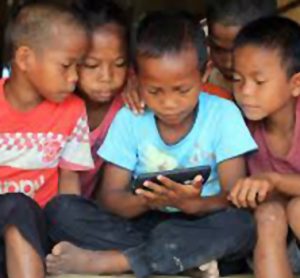Mal Lee and Roger Broadie
Trust is critical to the young growing ‘being digital’ (Lee and Broadie, 2018a).
Without trust the young will never normalise the use of the digital, and naturally enhance their use of and learning with the continually evolving digital technologies.
It is a new reality that most schools and governments don’t appear to have grasped. Rather globally we see them continuing to distrust and disempower the students, somehow imagining their unilateral control of the students every use of the technology will enable its normalisation, and enhance the nation’s young being digital.
Little is the wonder that near on two billion young (ITU, 2017) (UNICEF, 2017) have normalised the 24/7/365 use of the digital outside the school walls, but relatively few schools globally have been able to achieve that normalisation and have the digital underpin all learning.
We know now that five interconnected conditions are critical to the young’s sustained, natural learning with the digital (Lee, Broadie and Twining, 2018).
- Ready access to the personal, preferably mobile technology
- Digital connectivity
- Support, empowerment and trust
- Largely unfettered use
- Self-directed learning, able to collaborate when desired.
In providing the children their ‘own’ suite of digital technologies, free to configure them as they wish the digitally connected families are communicating very strongly to the kids the family’s trust in them.
In schools insisting the students use the prescribed digital device and software, in monitoring its every use and in failing to recognise and value the student’s out of school learning with the digital schools are saying very strongly – intended or not – we not only distrust you, but we don’t trust anything you do out of our eyesight.
In enabling the children to connect to the digital technology and the networked world the moment desired, and to do so largely unfettered the family is affirming both its trust in the kids as well trust in the upbringing and education the family has provided.
One will struggle to find a school anywhere that allows, let alone encourages students to digitally connect the moment they believe it will assist their learning, free to access the desired sites and facilities. Rather access is tightly controlled, with the students invariably needing to get teacher permission, to operate within a mandated acceptable use policy, to do at specified times and to work through a tightly controlled, filtered and indeed censored network.
In addition to trusting their children to use the technology and connectivity largely unfettered the family trusts their young to take charge of their learning with the digital technology, they decide what they want to learn, when, how and with the help of whom. Moreover, they are trusted to do so from as young as three, and supported from that age onwards to become autonomous learners, charting their individual path.
Importantly the families – likely unwittingly – trust their children to adjudge their own capabilities and to decide when, and how they best enhance their learning.
In contrast governments and their schools allow the same empowered young no voice in the in-school learning with the digital, with the experts and teachers deciding what needs to be learned, controlling every aspect of the teaching and assessment, with most schools neither valuing or recognising the student’s individualised learning with the digital. Tellingly not only are the children distrusted, so too are their parents.
Most schools remain strongly hierarchical organisations, tightly controlled by both government and the school executive, with not only the children and the parents distrusted but so too most teachers. Teachers globally are disempowered and micro-managed to the nth degree. Teachers, almost as much as the students are invariably obliged to use the school specified hardware and software, to use a tightly controlled network, and to follow the prescribed syllabus and assessment regime.
There are, as indicated, exceptional schools that have trusted and empowered their teachers, students and families, which have successfully built upon that trust in a BYOT program, normalised the whole school use of the digital, and vitally collaborated with the families in enhancing the children being digital (Lee and Levins, 2016).
But they remain the exception – their continued success strongly dependent on visionary often maverick heads, able to politic their way through the myriad of bureaucratic and government constraints.
Until governments and their senior education decision maker – be it a minister or superintendent – understand the centrality of trust, and openly promote school cultures that build on trust and empowerment schools will likely continue to have limited impact on the nation’s young being digital. Yes, there will always be exceptional heads, schools and classroom teachers that do make a difference. But there will continue to be, as there has been for near on forty years, great teachers burnt out by dated, stultifying organisational structures, and decision makers who refuse to let go of their control, and genuinely trust and empower the professionals, parents and students.
In advocating working from a position of trust the authors are not naively saying there is no need for astute control, for agreed operational parameters, for hierarchical structures and final decision makers. We are also conscious of the profound impact of the digital in the last twenty plus years and that public policy makers invariably lag 10-15 years behind the technological developments (Deloitte, 2017).
We are simply commenting on the global reality that in the last twenty plus years outside the school walls when the young are trusted and supported to use and learn with the evolving digital technology they naturally grow and evolve their being digital. Moreover, they are on trend to do so lifelong.
When distrusted and disempowered they don’t.
In 2016, the authors wrote on ‘Trust and Digital Schooling’ (Lee and Broadie, 2016), noting then the inability to successfully create digital schools without trust. We observed:
Without trust schools can’t thrive in a socially networked society and sharing economy (Lee and Broadie, 2016).
Two years later, and having scrutinised the evolution and success of the digitally connected families and researched the digital education offered by schools worldwide between 1993 – 2016 (Lee and Broadie, 2018b) we more than ever stand by that observation, and add that without trust schools cannot grow the nation’s young being digital.
- Deloitte (2017) Rewriting the Rules of the Digital Age: Deloitte Global Human Capital Trends Deloitte University Press – https://www2.deloitte.com/au/en/pages/human-capital/articles/global-human-capital-trends-2017.html
- ITU (2017) Measuring the Information Society Report 2017 Volume 1 Geneva International Telecommunications Union – https://www.itu.int/en/ITU-D/Statistics/Pages/publications/mis2017.aspx
- Lee, M and Broadie, R (2016) ‘Trust and Digital Schooling’. Educational Technology Solutions – August 2016 http://www.educationtechnologysolutions.com.au/2016/08/trust-digital-schooling/
- Lee, M and Levins, M (2016) BYOT and the Digital Evolution of Schooling Armidale Douglas and Brown – http://douglasandbrown.com/publications/
- Lee, M and Broadie, R (2018a) ‘Being Digital’ Linkedin – https://www.linkedin.com/pulse/being-digital-mal-lee/?published=t
- Lee, M and Broadie, R (2018b) Digitally Connected Families. And the Digital Education of the World’s Young, 1993 – 2016,Armidale, Australia, Douglas and Brown – http://douglasandbrown.com/publications/–
- Lee, M. Broadie, R and Twining, P (in press) Your Kids Being Digital. A Guide for Digitally Connected Families .
- UNICEF (2017) Children in a Digital World. UNICEF December 2017 – https://www.unicef.org/publications/files/SOWC_2017_ENG_WEB.pdf








